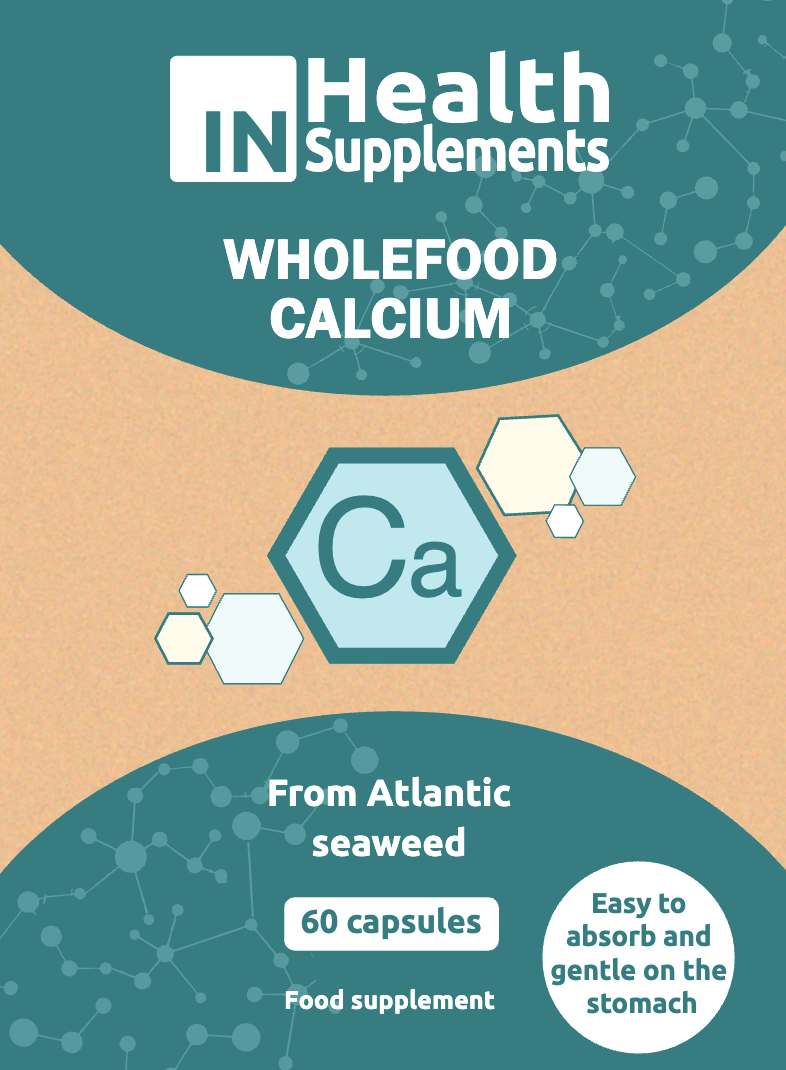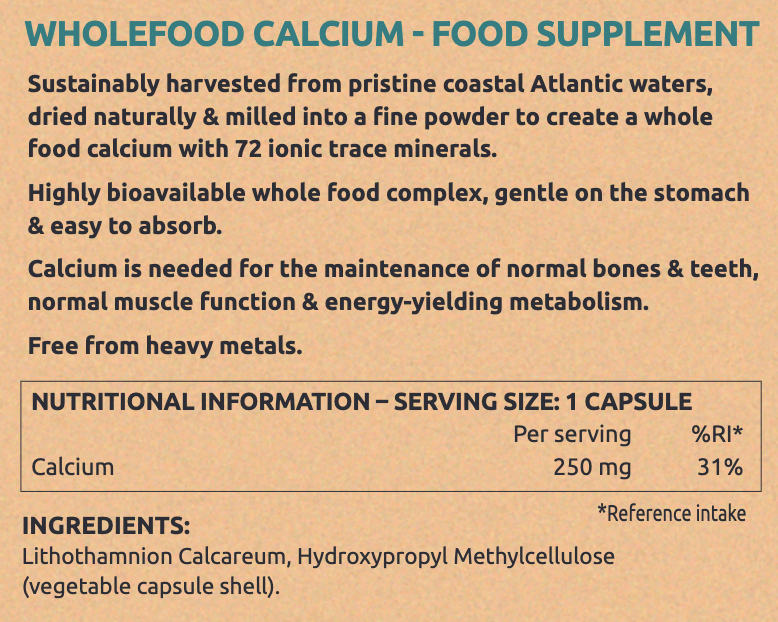Today we have a very special guest on webinar in the form one of my mentors, Simon King, who originally trained as a Chiropractor, graduating in 1986, though he is now a deregistered, and is a muscle testing innovator (link at the end).
It was Simon that first alerted me to the potential of using calcified seaweed as a source of whole food calcium.
I have been using it ever since and, as a result, we now have it as part of our range.


As a trade case of 6, it works out as £11 per pouch with an RRP of £15 but the end price is up to you.
250 mg of whole food calcium per capsule, 60 capsules per pouch.
Simon kindly gave up an hour of his time to go over the benefits of whole food calcium in clinical practice.
Some of the highlights include:
– How calcium translates the electrical signal from the nerves into a mechanical event (I did not know about this)
AKA Calcium can make your muscles stronger.
– Calcium in the blood vs calcium in the cell (your body ALWAYS keeps blood calcium constant via PTH, but are you low on a cellular level?)
– Calcium’s critical role in immunity
– Supplements vs food (remember the whole food supplement is actually a food as it is dried, milled calcified seaweed)
– Wholefood calcium for knee arthritis studies x2
👀

– Simon’s dosing schedule and clinical indicators for use plus an amazing video of Simon examining a patient before and after wholefood calcium.
– Common causes of low calcium as Simon sees it. There were a couple of causes he mentioned I had never heard of.
And there is a difference in opinion on vitamin D as Simon tends to use calcium over vitamin D, and he doesn’t use K2 either.
Here is the nuance in divergence of thought, which I suspect is at least partly due to Simon using muscle testing exclusively for diagnosis. While I would use it inclusively (along with blood testing and a deeper dive into vitamin D physiology).
Remember, without vitamin D you cannot absorb calcium from the gut into the blood, whole food or otherwise (as far as we know).
Your calcium absorption maxes out at 85 nmol/L.
Note: if you go from 50 nmol/L to 85nmol/L your calcium absorption increases 65 %, which is ALOT of calcium and the NHS are not aware of this.

Going up beyond that over 100 nmol/L does nothing for calcium but…..it will likely help your immune system function optimally.
So, if we have someone with vitamin D of 50 nmol/L and, as a result, they are under absorbing calcium into the blood, giving them extra calcium will give more calcium into the system overall and give a positive response.
But it doesn’t make sense to me to leave them low in vitamin D, bypass the absorption issues from low vitamin D, with extra calcium (of any sort), and with a weakened immune system.
IMO, the issue might be with the manual muscle testing picking up tender and soft bones, due to low calcium, and so when we test with calcium it is +ve.
Yes, they need more calcium in the bones, but, it is a downstream manifestation of sub-optimal vitamin D or K2 (which puts calcium into the bones).
It is Simon’s opinion that the quality of dairy, due to pasteurisation, animal feeding practices etc, is lower than when it is raw from a grass fed animal.
And that is why many people eating dairy still need whole food calcium.
And he may well have a point.
Isn’t it nice to have discussions with people who have different opinions than you?
We talked about that here 👇 and it is how you learn.
https://www.academyofchiropracticnutrition.com/egos-tribes-and-certainty/
Click it 👇

Either way, when Simon says he gets consistently positive results with anything in clinic, I listen, try it and integrate it.
In the land of EBM zealots and practice building gurus, we need stuff, not fluff, and we need integrity.

The reason I trust him this much?
I learned his cervical disc adjustment and have used it daily since 2001. It is reliably life changing.
And I have added many more of his gold nuggets since (coupled adjusting, hidden inguinal hernia technique), also with excellent effect.
He keeps evolving (he has been in practice 39 years 🤯) as he sees more patients and is 100% focused on results, not theory.

If you do not assess people properly, how do you know your care is working?

It is also possible the mechanism is not just calcium, as this is a whole food product with 72 trace minerals as well.

ndeed, the authors of the two studies for knee arthritis specifically mention the trace minerals in relation to benefits from the product.
They note that copper, boron and manganese are all involved with connective tissue production.
Selenium in the production of the anti-oxidant GLUTATHIONE, and zinc and magnesium in inflammation.
Simon believes the calcium translating the nerve impulses into stronger muscle contractions, makes the patient stronger and hence they can walk further (one of the tests used in the study).
Pink = Wholefood calcium, dark blue = placebo.

Some low hanging fruit for you all is swapping patients on GP prescribed calcichew, to the whole food calcium.
Calcichew is also known as calcium carbonate, or CHALK.

Ask them if it tastes chalky…….answer yes, as it literally is.
And they do not like the taste.

The issue is, firstly, it is hard to absorb, and secondly, the carbonate part is alkalinising.
In your stomach you need acid to absorb minerals, like calcium, iron, magnesium etc and calcium carbonate, neutralises acid.
This is so effective you can buy it as heartburn tablets.

Check the ingredients:

Hence, when patients take Calcichew, they often feel bloated and nauseous, because they have just neutralised their stomach acid and now they cannot digest and absorb.
Remember, unless the stomach gets very acidic, the pyloric sphincter (bottom of the stomach), will not open and empty the stomach.
Thus, you feel full quickly, and food starts to ferment, and you bloat.
Note the bloating often then increases intra-abdominal pressure, which opens the oesophagus sphincter, and the little acid you do have goes into the oesophagus, and you get reflux. So you take more anti-acid tablets……..
Anyhoo, you can now step in and add in the easy to absorb, whole food calcium with research to back it up.
Also, consider those who have reduced dairy in their diets, as this is the main source for most people.
The challenge with getting calcium from plants only is two fold:
– The dose in mg of calcium per serving is often lower than dairy.
– The bioavailability is often lower, secondary to inhibitors like oxalates, phytic acid and fiber.
See below, kale has high bioavailability, but low dose compared to dairy, so the overall yield is far lower. While spinach has a high dose but only 5% absorption.

And in reality, how many times a day are you willing to eat spinach and kale to get your RDA/RI of 800 mg?
While dairy, let’s face it, is delicious and people can eat it many times a day.

Plus, dairy is a complete food, nothing else naturally has protein, fats, carbs, vitamins and minerals.
Babies have milk only till 6 months, and they grow pretty well.

